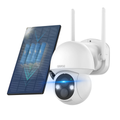What is a Night Vision Camera?
Introducing the Night Vision Camera: In the highly advanced urban landscape, many locations and scenarios that require round-the-clock surveillance are unable to provide continuous illumination. This is not only a wasteful use of resources but also contributes to light pollution. Similarly, in the untouched wilderness, numerous creatures become active only after nightfall, and the presence of artificial lighting can significantly disrupt their natural rhythms. That's where Night Vision Cameras come into play.
At OHWOAI Surveillance, we primarily utilize infrared night vision cameras, which employ infrared technology to achieve the "night vision" capability.
Working Principle of Night Vision Cameras: Night vision surveillance cameras, typically equipped with infrared technology, operate by actively projecting infrared light onto objects in dark environments with no visible light or only minimal ambient light. The infrared light reflects off the objects and enters the camera lens for imaging.
By emitting infrared light, the infrared camera illuminates the subject, and the reflected infrared light is received by the monitoring camera, forming a video image. This concept can be likened to using a flashlight in the dark, where the flashlight acts as the infrared light source, and the camera acts as the human eye. Consequently, the captured image consists of reflections from infrared light rather than visible light, enabling the recording of scenes invisible to the naked eye in dark environments.
Importance and Applications of Night Vision Cameras: The LED lights on infrared cameras serve a crucial purpose by providing illumination in environments with little or no lighting, ensuring clear surveillance footage. This type of light is invisible to the human eye, making it discreet and unknown to the subjects being recorded. Infrared light, though imperceptible to the naked eye, is a form of radiation.
The physical principle underlying infrared night vision revolves around the fact that objects with temperature differences transfer heat from higher to lower temperatures. This transfer primarily occurs through infrared radiation. High-temperature objects emit infrared radiation, which is undetectable to the human eye. However, the image sensor, whether CCD or CMOS, in a surveillance camera can receive and convert this radiation into electrical signals, subsequently processing them into visible images.
At OHWOAI Surveillance, we offer a wide range of advanced security solutions, including low-voltage security cameras, 4K surveillance cameras with DVR, complete security camera systems for residential use, 8-camera HD security systems, 4-camera security systems with PoE, and CCTV surveillance camera systems. Our cutting-edge 4K IP security cameras provide unparalleled image quality and resolution, ensuring that you capture every detail with clarity and precision.
Choose OHWOAI Surveillance for superior surveillance solutions that prioritize your safety and peace of mind. Contact us today to explore our comprehensive range of security camera options.
Sample Block Quote
Nam tempus turpis at metus scelerisque placerat nulla deumantos sollicitudin delos felis. Pellentesque diam dolor an elementum et lobortis at mollis ut risus. Curabitur semper sagittis mino de condimentum.









